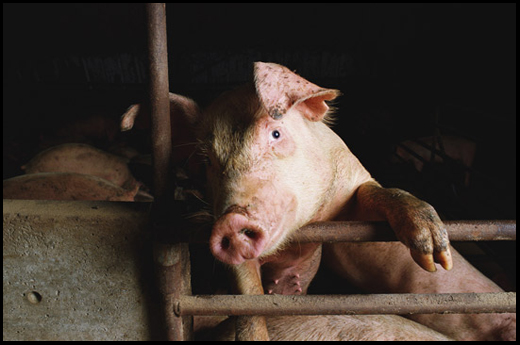By guest blogger Andrew Gunther, program director of Animal Welfare Approved
As our domestic demand for intensively produced meat continues to drop dramatically, we are about to let the meat industry continue to pollute our environment and make our families sick in order to profit from China’s appetite for meat.
For years, proponents of the dramatic industrialization of the meat industry in the U.S. have hailed it as an all-American success story because it provides U.S. citizens with an abundant supply of cheap animal protein. “Americans spend less than any other developed nation in the world on food broadly, and on meat and poultry specifically,” boasts the American Meat Institute, while the implicit message of its “Meat Fuels America” campaign means that anyone who criticizes the intensive meat industry is somehow anti-American or anti-progress. This type of clever marketing hides the fact that the real cost of the meat we eat is extraordinarily high when we account for its environmental costs and its costs to human health and animal welfare.
Recent reports indicate that meat consumption in the U.S. is declining steadily every year. According to the latest figures from the U.S. Department of Agriculture (USDA), the average American will consume 12.2 percent less meat and poultry in 2012 than in 2007. And while a number of factors are likely to be at play, the growing public awareness of the impact of industrial livestock farming on our health, animal welfare, and the environment has undoubtedly had a role in this decline in demand.
Surprisingly, despite the declining consumer preference for intensively produced meat and the clear message that consumers want the intensive livestock industry to clean up its act, the number of concentrated animal-feeding operations (CAFOs) in the U.S. is actually increasing. It might also surprise you to know that this recent expansion of CAFOs is not about providing U.S. citizens with abundant, cheap meat. Rather, it’s about producing and supplying cheap meat to China. And U.S. citizens are the ones who will pick up the check.
According to the influential Earth Policy Institute, more than a quarter of all the meat produced worldwide is now eaten in China, and the country’s 1.35 billion people are hungry for more. Today, China’s annual meat consumption is more than double that in the U.S. With U.S. meat consumption falling and Chinese consumption still rising, the U.S. intensive meat industry is turning to China as an alternative market for its unwanted products. According to a recent report in Iowa Farmer Today, China was the sixth-largest buyer of pork from the U.S. in 2006, representing 5 percent of U.S. exports, but it moved to the third-largest buyer by 2011, representing 15 percent of U.S. exports. Recent USDA figures show that this trend has continued into 2012: “Chinese imports of U.S. pork products in April were almost three times higher than a year ago.”
These global market opportunities have not gone unnoticed: An article in the Des Moines Register published earlier this year (June 22, 2012) reported that the number of applications for CAFOs in Iowa has increased dramatically over the last three years. With a pig population of 19.7 million, Iowa is the largest producer of intensive pork in the U.S., but a similar expansion of CAFOs is also underway in other states.
Industrial hog operations produce vast quantities of concentrated waste called swine effluent, a toxic concoction of pig feces, heavy metals, bacteria, and of course, residues from the concoction of pharmaceuticals that are given to the pigs to keep them alive in the CAFOs’ confined conditions. Most U.S. factory farms pump this swine effluent in vast nearby open tanks or cesspools. Some of these lagoons are as big as several football fields, each holding hundreds of thousands—if not millions—of gallons of putrefying swine effluent. Because this effluent is expensive to store or treat, most industrial systems periodically pump the waste out of the lagoons and spray it on surrounding fields. The problem is that it is often sprayed at such high application rates or so often that the soil and plants cannot even begin to absorb it, let alone actually utilize it. This level of overapplication frequently leads to highly toxic runoff, and the water-soluble nutrients find their way into our waterways and groundwater systems in vast quantities, polluting our drinking water and rivers, leaving our waterways dead.
It would appear that the Chinese are only too aware of the environmental problems associated with the expansion of intensive pig production systems in their country. A recent USDA report, entitled China’s Volatile Pork Industry, states that “Producing large quantities of pork in China entails ‘external’ costs—the environmental impacts of hog waste and risks of food safety incidents—that are not factored into the market price of pork.” So it seems that the Chinese are happy to pay other countries to produce their meat, thereby avoiding the associated environmental and health costs to their own citizens.
But while the same USDA report would like us to believe that U.S. farmers produce pork “with less of an impact on the environment, fewer food safety incidents, and fewer disease outbreaks than in China,” a significant body of scientific research shows that this is not necessarily the case. A review of the impacts of waste from concentrated animal-feeding operations on water quality published in 2007 found that the livestock waste-management practices found on most U.S. industrial livestock operations were not sufficient. Based on available data, the researchers said, “generally accepted livestock waste-management practices do not adequately or effectively protect water resources from contamination with excessive nutrients, microbial pathogens, and pharmaceuticals present in the waste.”
Recent research has also revealed that the toxic emissions from U.S. industrial hog operations—including gases, fecal waste dust, and bacteria—are causing serious adverse health effects on U.S. citizens and making their lives miserable. A March 2011 paper published in the journal Epidemiology examined the health of residents in 16 communities in a region of North Carolina that is densely populated with industrial hog operations. The researchers looked at the associations of reported hog odor and monitored air pollutants with the physical symptoms and lung function of people living within 1.5 miles of hog operations. They found that air pollutants from the hog operations were causing acute physical symptoms, including eye and nasal irritation, respiratory symptoms, difficulty breathing, wheezing, chest tightness, and nausea, among other symptoms. The evidence was so great that the researchers concluded, “Exposure to air pollution from hog operations is an environmental injustice in rural areas hosting facilities that supply pork to populations spared the burdens of its production.” Forgive me, but aren’t these exactly the kind of “external costs” that the USDA has already said that Chinese are looking to avoid domestically? If you needed further evidence, just look at recent efforts in China to develop free-range pig operations.
Despite the growing concern among U.S. consumers about the impact of intensive livestock operations on our health and the local environment, the intensive-pig-farming industry is now expanding the number of CAFOs to meet growing Chinese demand for cheap pork—and it is more than happy to pollute our environment and harm our health in doing so. But at least it’s now amply clear to us all that the intensive meat industry isn’t too concerned about feeding America sustainably or protecting its environment. The real concern is protecting the industry’s business interests and maximizing profits—regardless of the costs.
 Andrew Gunther joined Animal Welfare Approved (AWA) as program director in April 2008. Working with pasture-based farmers across the U.S. and Canada, AWA provides consumers with the reassurance that the milk, cheese, eggs, and meat bearing the AWA seal come from family farmers using high-welfare, sustainable agriculture methods. Previously, Gunther was senior global animal compassionate product procurement and development specialist for Whole Foods Market. With his wife and children, he also pioneered the world’s first organic poultry hatchery for chickens.
Andrew Gunther joined Animal Welfare Approved (AWA) as program director in April 2008. Working with pasture-based farmers across the U.S. and Canada, AWA provides consumers with the reassurance that the milk, cheese, eggs, and meat bearing the AWA seal come from family farmers using high-welfare, sustainable agriculture methods. Previously, Gunther was senior global animal compassionate product procurement and development specialist for Whole Foods Market. With his wife and children, he also pioneered the world’s first organic poultry hatchery for chickens.





ONE IN FOUR PIGS IN AMERICA IS OWNED BY…..CHINA….! HOW MANY CAFO’S ARE ALSO OWNED…..?